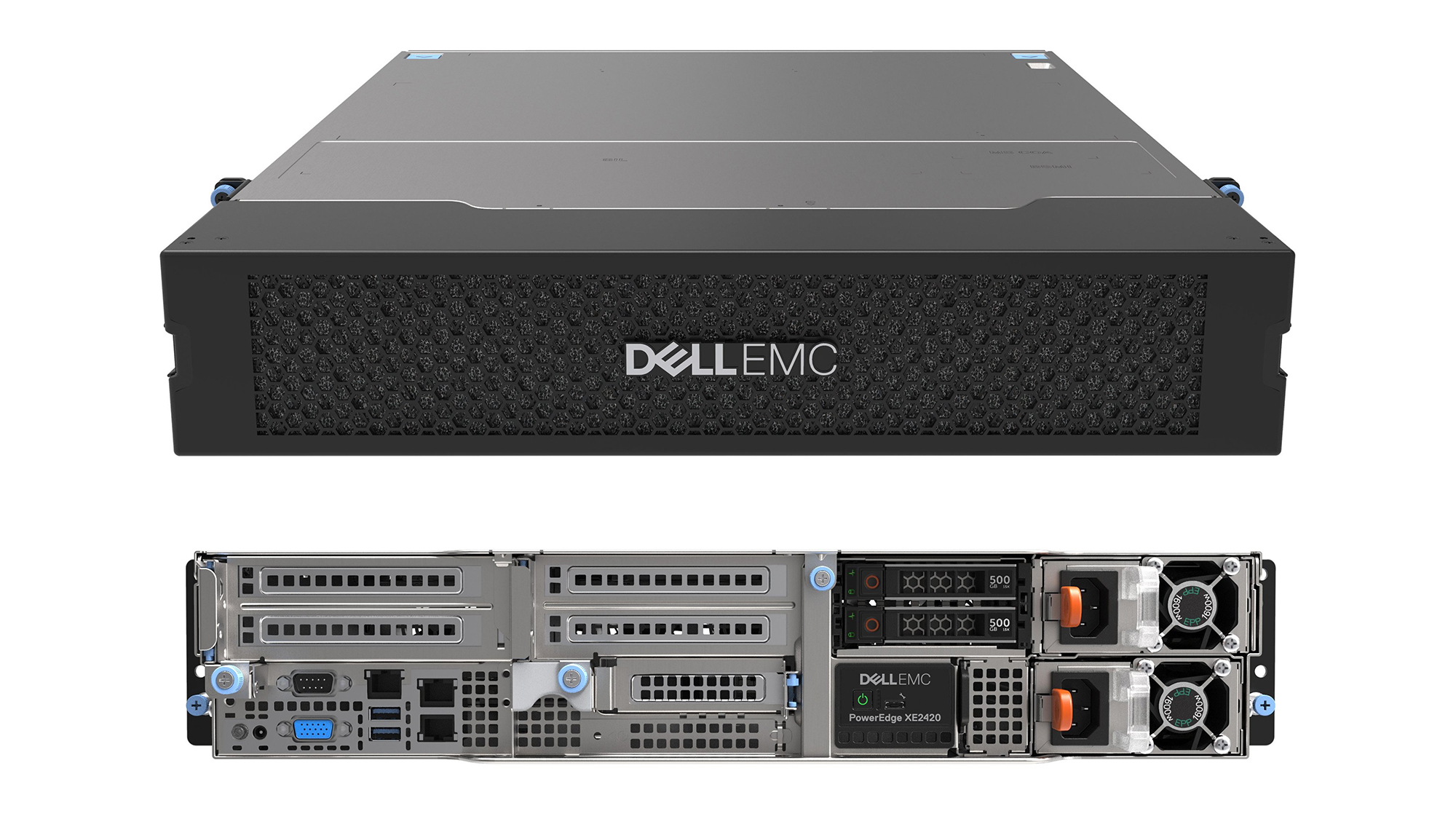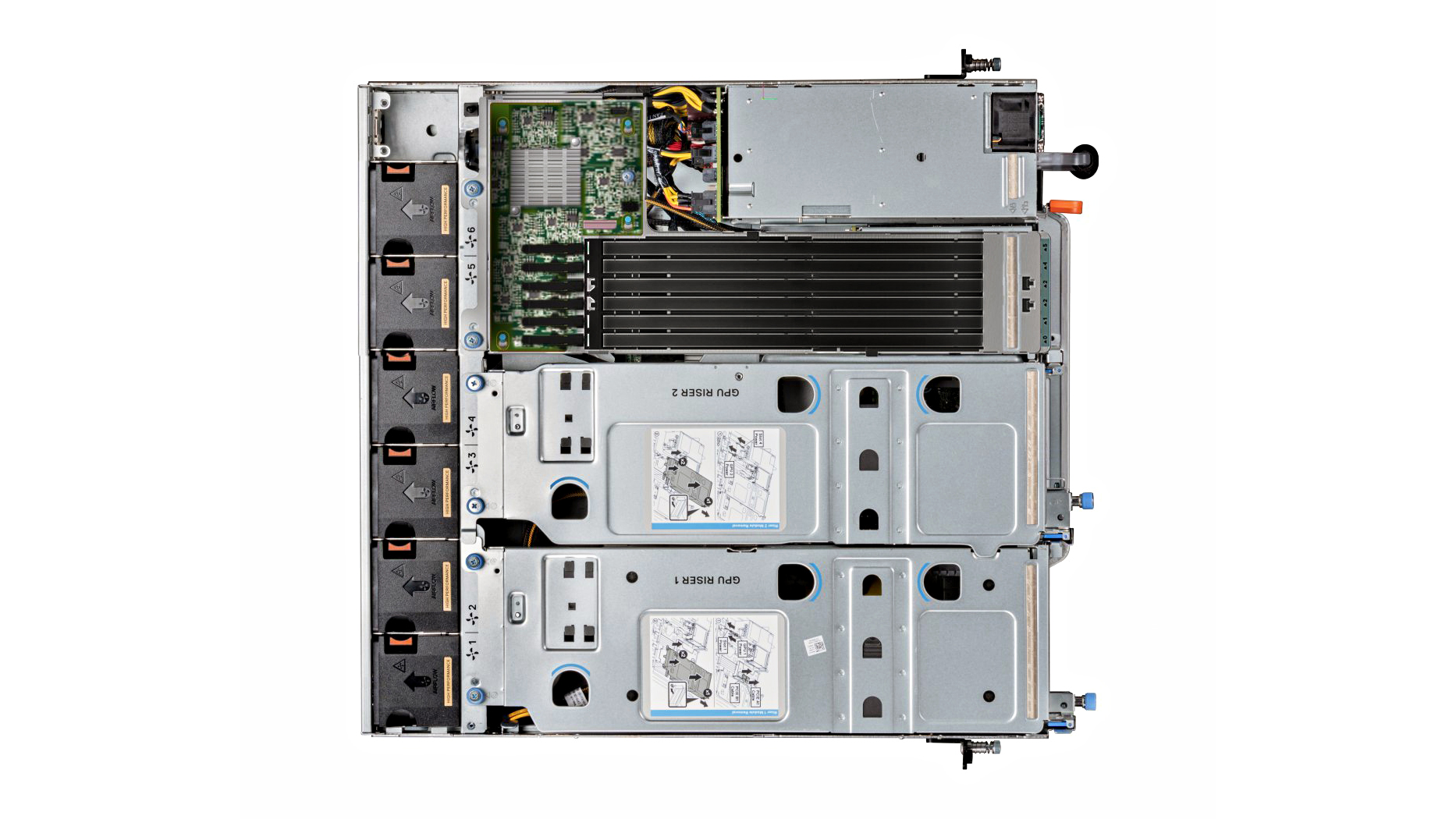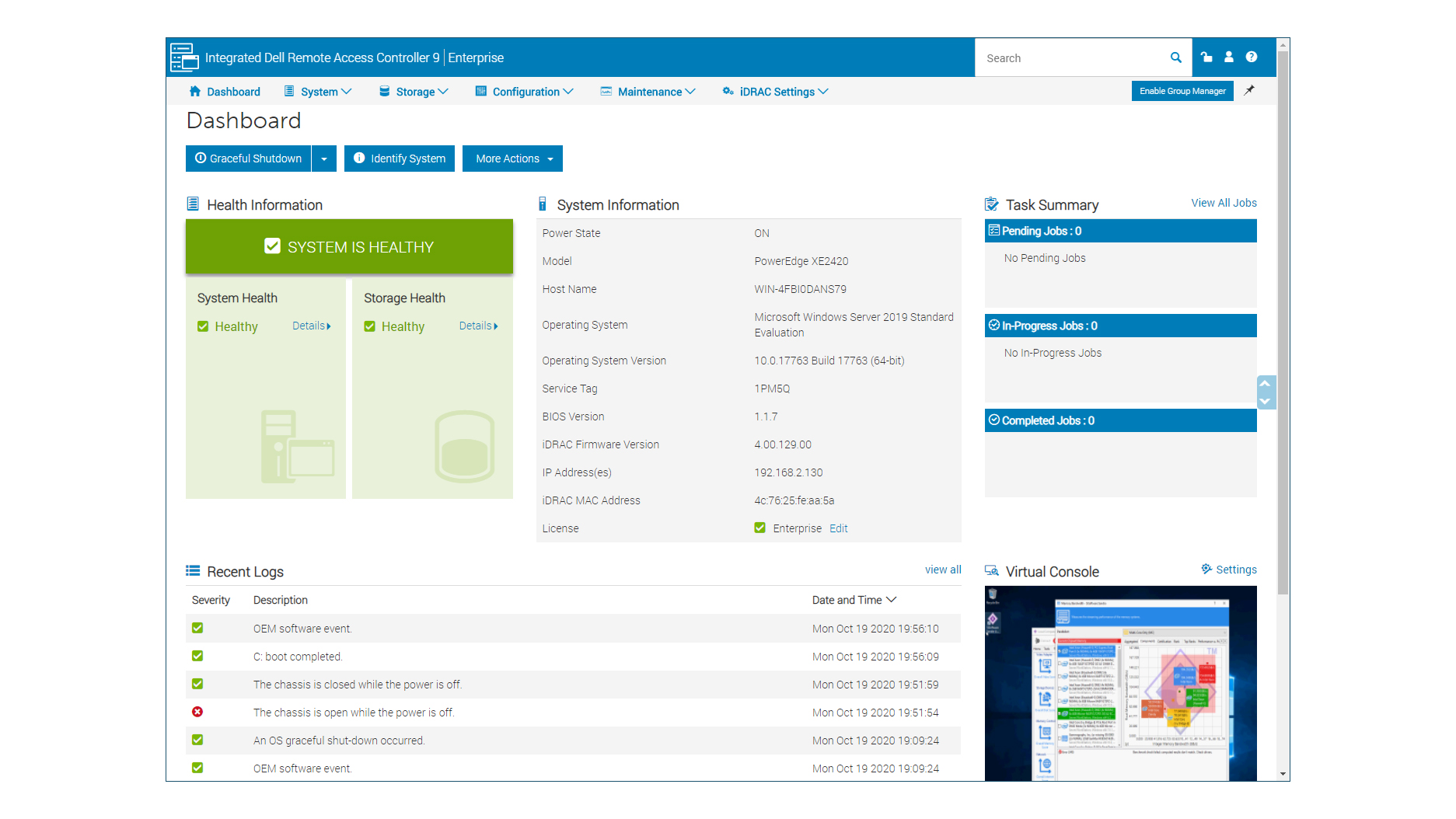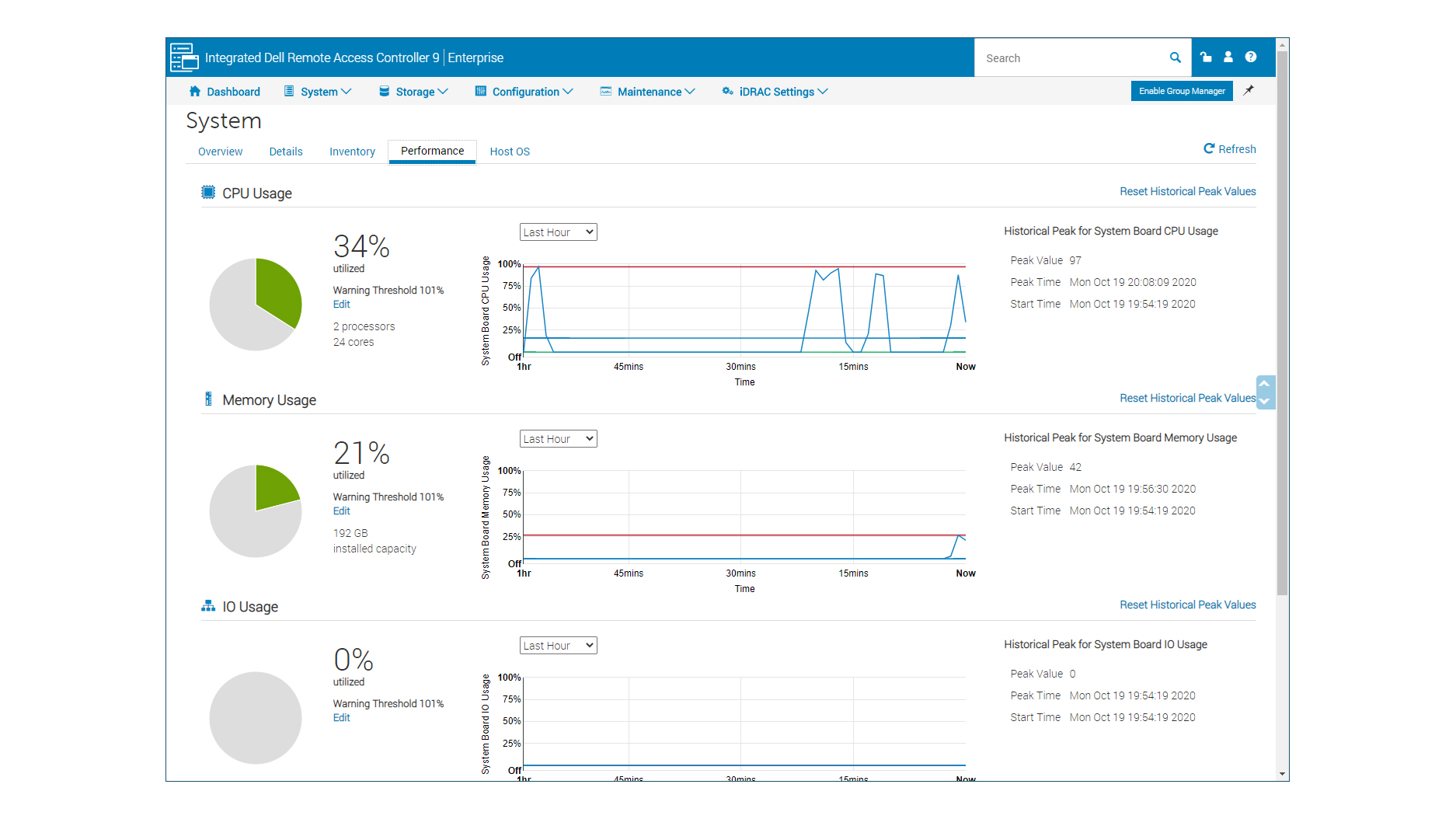Dell EMC PowerEdge XE2420 review: Living on the edge
The compact and powerful XE2420 puts advanced analytics at the outer limits


-
+
Space-saving chassis
-
+
Xeon Scalable CPU support
-
+
Remarkable expansion potential
-
+
Smart storage options
-
+
Big GPU capacity
-
+
iDRAC9 remote management
-
-
A little pricey

The Dell EMC PowerEdge brand name may have first appeared way back in the mid-90s but for the XE2420, it’s never been more appropriate. This 2U rack server is, quite simply, designed to deliver some serious computing power to the network edge.
The XE2420 targets a wide range of edge computing applications including 5G adoption, retail, analytics, transport, plant automation, automotive industry in-car testing, shopping malls, VSANs, energy production and much more. It’s designed to work in harsh environments in temperatures of between 5 and 40 degrees C and its large bezel accepts an optional dust filter.
A striking feature is the short-depth chassis, which measures only 557mm with the bezel attached, allowing it to go where normal rack servers can’t. Don’t be fooled by this shortness through; the XE2420 is capable of packing a mighty specification.
It supports dual Xeon Scalable CPUs including the Cascade Lake models, while memory can be boosted to a maximum of 1TB with RDIMMs and 1.75TB using LR-DIMMs. Storage options are plentiful as well, but a key feature is its facilities for up to five PCI-E expansion slots, with GPU cards a high priority.
Dell EMC PowerEdge XE2420 review: System design
The XE2420 employs a reverse system design with all expansion slots, drive bays and network ports accessible from the front. All system cooling is handled by a bank of six high-performance hot-plug fans arranged across the rear of the chassis.

Our system was supplied with two meaty 2kW Platinum hot-plug PSUs, which are also accessed from the front and use a reverse air-flow design. The bezel is a chunky lump of steel and along with the removable dust filter in the front, it has apertures with dust brushes on each side for cable connections.
There’s a lot going on underneath the lid and Dell EMC has packed a lot of hardware into this server. You can’t miss the two reinforced GPU expansion cages, which run the full length of the chassis and have two 16X Gen 3 PCI-E slots apiece - all supporting full-height (FH), full length (FL) cards.
The motherboard lurks underneath these cages and presents dual CPU sockets accompanied by a total of 16 DIMM slots. The system on review is well-specified; the price we’ve shown includes a tasty pair of 2.7GHz 12-core Intel Xeon Scalable Gold 6226 CPUs, partnered by 192GB of 2,933MHz DDR4 memory.
Dell EMC PowerEdge XE2420 review: Storage and expansion
Dell EMC offers three versions of the XE2420 and on test we have the 1A model, which supports two SFF drives. You can opt for SATA drives, but our system has the NVMe riser card installed and includes a pair of 3.84TB NVMe SSDs.
The 2C model supplants the leftmost PCI-E riser with a second dual-drive SFF cage, while the 3A version brings EDSFF (Enterprise & Data Center SSD Form Factor) into the storage equation. Remarkably, there’s enough room inside for an EDSFF switch backplane and full-length cage, which supports six E1.L (long) SSDs allowing storage capacity to be pushed to 92TB.

Graphics options are extensive, and the server supports two x16 300W or four x8 75W passive GPU cards. The XE2420 has an upper 150W TDP threshold for CPUs but this does cover all the Bronze, Silver and Gold 5200 Gen2 models, along with a fair few Gold 6200s.
Expansion options don’t stop here - the motherboard offers an OCP slot which, although it’s the older 2.0 variety, accepts dual-port 10GbE or 25GbE mezzanine cards. A fifth PCI-E slot sits above this as the centre slot riser has an interposer board cabled to it and its slot supports a half-width, half-length card.
We also have Dell EMC’s trusty BOSS (boot optimized storage solution) card, which is tucked neatly away in a dedicated slot underneath the central drive cage. This was fitted with dual 480GB M.2 SATA SSDs in a mirrored array allowing us to run an OS without using any front bays.
Dell EMC PowerEdge XE2420 review: Remote management
The XE2420 sports a full-strength embedded iDRAC9 remote management controller, which presents a smart web interface offering a wealth of information on system and component status, power usage and cooling efficiency. Along with full hardware inventory, it provides direct access to the server’s BIOS plus storage configuration, and the Enterprise license included in the price activates OS remote console and virtual media services.
Deployment is a cinch; we just used the remote console to map a Windows Server 2019 ISO to the XE2420 as a virtual drive. We then handed this over to the Lifecycle Controller feature for installation and selected the BOSS card as the destination.

The iDRAC9 has a sharp focus on security, with a System Lockdown mode stopping users making any configuration changes, while full supply chain security is assured by cryptographically signed firmware packages. Upgrading to the Datacenter iDRAC9 license enables telemetry streaming of over 20 hardware metrics for analytics, plus thermal and airflow management and tighter access security with automatic certificate enrolment.
Sadly, the XE2420 doesn’t support the Quick Sync 2 module, which enables mobile connections over Bluetooth for walk-up diagnostics using the OpenManage Mobile (OMM) app. All is not lost though, as we could use the OMM app to access the server over the LAN, and also plug a USB cable into the small control panel at the front and connect directly to a Windows laptop for accessing the iDRAC9 web interface using the standard RNDIS driver.
Dell EMC PowerEdge XE2420 review: Verdict
You do pay a premium for its compactness, but the PowerEdge XE2420 is perfect for enterprises that want to push some serious compute and data analytics power out to the network edge. The space-efficient short-depth chassis is surprisingly expandable, it supports a high GPU density and offers a wide range of storage options including the latest high-capacity EDSFF SSDs.
Dell EMC PowerEdge XE2420 specifications
| Chassis | 2U short-depth rack |
| CPU | 2 x 2.7GHz 12-core Intel Xeon Scalable Gold 6226 |
| Memory | 192GB 2,933MHz DDR4 (max 1,792GB with LR-DIMM) |
| Storage | Dell BOSS with 2 x 480GB M.2 SSDs, 2 x 3.84TB NVMe SSDs |
| Storage controllers | Dual-port NVMe SSD riser |
| RAID adapters | None included |
| Network | 2 x Gigabit |
| Expansion | 5 x PCI-E 3.0, OCP 2.0 |
| Cooling | 6 x hot-plug high-performance fans |
| Power | 2 x 2kW hot-plug reverse flow PSUs |
| Management | iDRAC9 Enterprise with Gigabit |
| Warranty | 3Yr ProSupport On-Site NBD |
Get the ITPro daily newsletter
Sign up today and you will receive a free copy of our Future Focus 2025 report - the leading guidance on AI, cybersecurity and other IT challenges as per 700+ senior executives
Dave is an IT consultant and freelance journalist specialising in hands-on reviews of computer networking products covering all market sectors from small businesses to enterprises. Founder of Binary Testing Ltd – the UK’s premier independent network testing laboratory - Dave has over 45 years of experience in the IT industry.
Dave has produced many thousands of in-depth business networking product reviews from his lab which have been reproduced globally. Writing for ITPro and its sister title, PC Pro, he covers all areas of business IT infrastructure, including servers, storage, network security, data protection, cloud, infrastructure and services.
-
 ‘Phishing kits are a force multiplier': Cheap cyber crime kits can be bought on the dark web for less than $25 – and experts warn it’s lowering the barrier of entry for amateur hackers
‘Phishing kits are a force multiplier': Cheap cyber crime kits can be bought on the dark web for less than $25 – and experts warn it’s lowering the barrier of entry for amateur hackersNews Research from NordVPN shows phishing kits are now widely available on the dark web and via messaging apps like Telegram, and are often selling for less than $25.
By Emma Woollacott Published
-
 Redis unveils new tools for developers working on AI applications
Redis unveils new tools for developers working on AI applicationsNews Redis has announced new tools aimed at making it easier for AI developers to build applications and optimize large language model (LLM) outputs.
By Ross Kelly Published
-
 Google layoffs continue with "hundreds" cut from Chrome, Android, and Pixel teams
Google layoffs continue with "hundreds" cut from Chrome, Android, and Pixel teamsNews The tech giant's efficiency drive enters a third year with devices teams the latest target
By Bobby Hellard Published